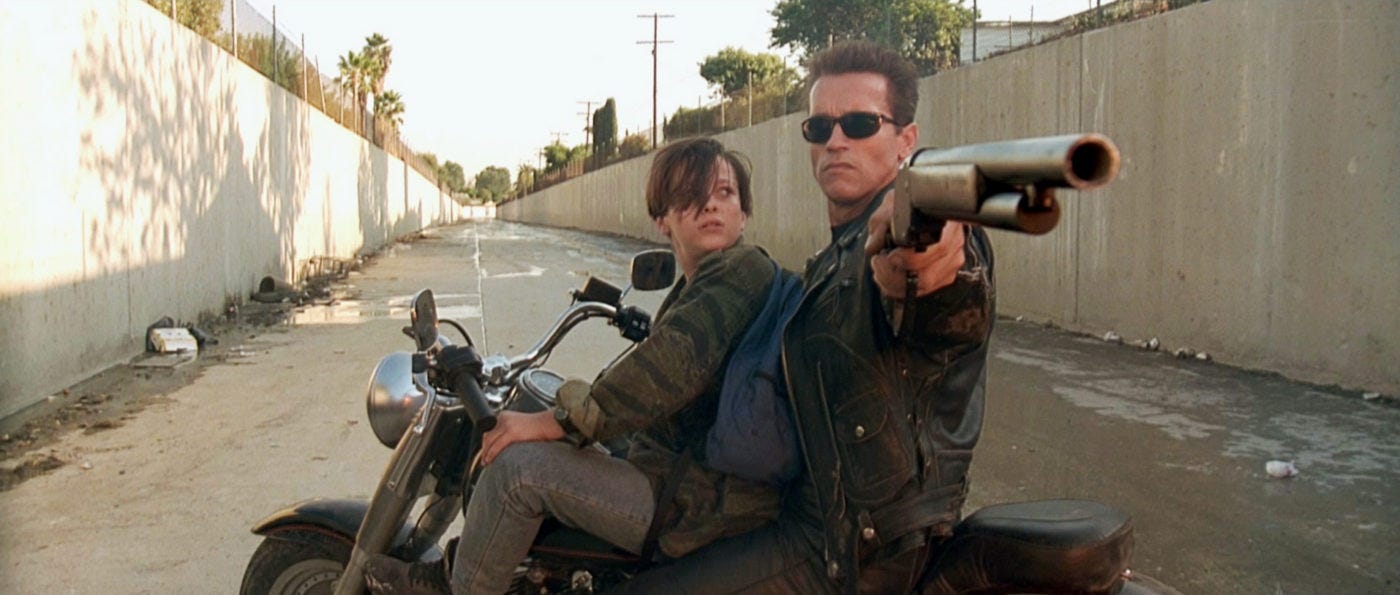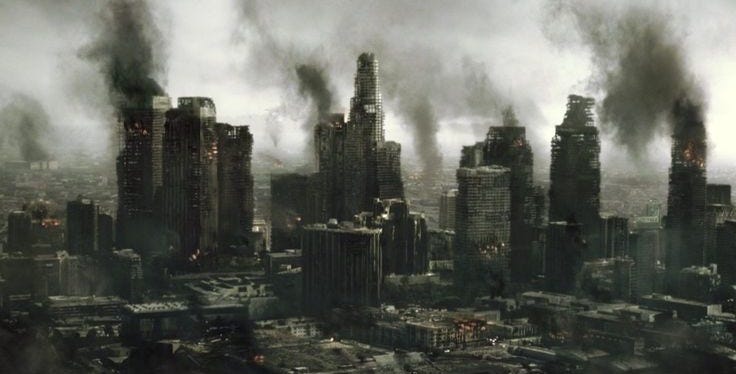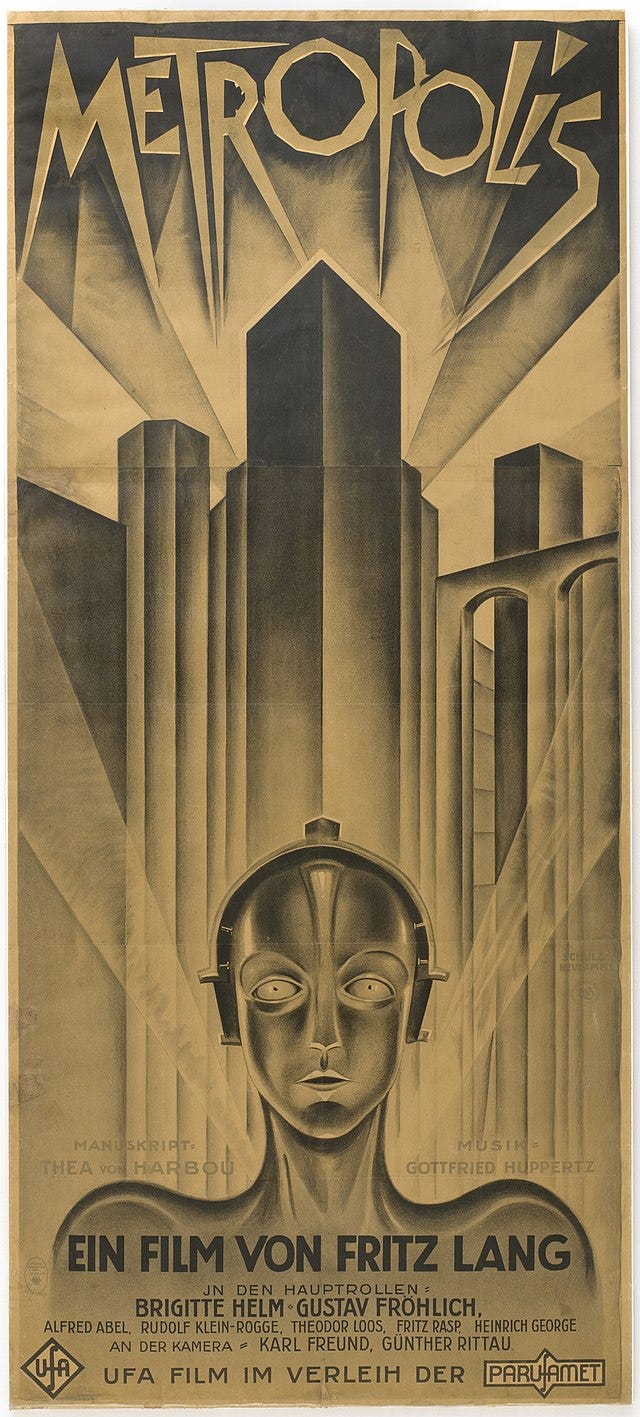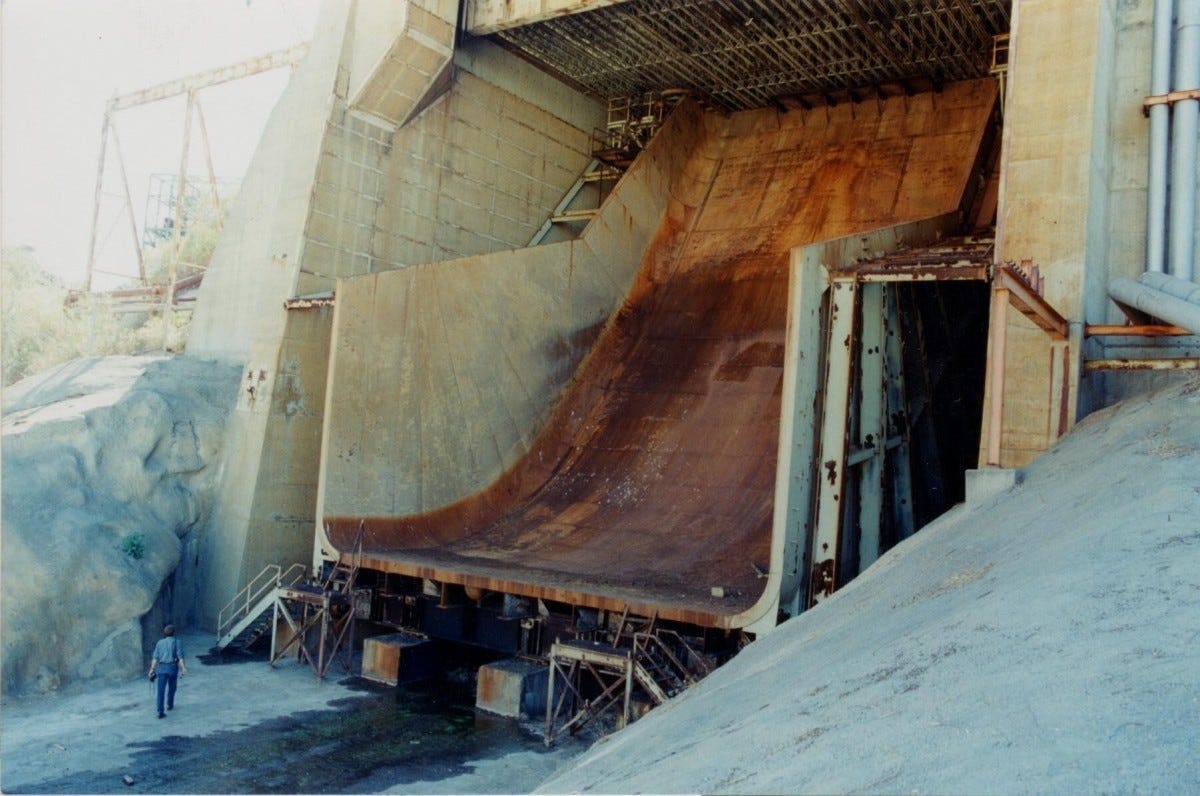Perhaps you’ve seen the news. Los Angeles is burning—worse than ever before. Fires keep starting. They keep on expanding. Give your phone a good long doom scroll. This is what it’s all about.
This scenario, the destruction of the Angel City, has been lovingly portrayed in film and literature no less than 138 times according to the last count of the late critic Mike Davis. “Los Angeles is the city we love to destroy.”
The Palisades Fire is slowly creeping toward me and a few more million people. Tom Petty’s house will probably be toast. Pick your favorite celebrity.
All the vampires walkin' through the valley / Move west down Ventura Boulevard / And all the bad boys are standing in the shadows /And the good girls are home with broken hearts —Tom Petty, “Free Fallin’”
But you can’t stay home. Evacuation orders extend to Ventura Boulevard. Not far from me. Feeling pretty good. I guess this vampire pictured below, a homeless man armed with a flame thrower, wandered off the Blvd and set the Kenneth Fire, just south of the Santa Susana Field Laboratory. Good stuff! Not a big deal. This is fine. Everything is fine.
I guess the dude probably read too much Mike Davis, Joan Didion, Morrow Mayo, Robinson Jeffers, Carey McWilliams, Nathaniel West, Brett Easton Ellis. All the good critics salting the ‘semi-tropical’ paradise with a century of very rational pessimism about the prospects of this most unnatural region. Fuck. Maybe the bro read me. The film critic at N+1, A.S. Hamrah, said my new book about Los Angeles and Joshua Tree, YUCK, is “an uncomfortable yet entertaining meditation on California and nature in the tradition of both Robinson Jeffers and Mike Davis.” Good stuff! At least Erewhon is offering Ophora Hyper-Oxygenated water at a discounted price to the community of Calabasas before it burns down. $19.99 for a special limited time instead of the regular $26.99. Pour some on the grass or something.
Why is any of this happening? What is happening? I don’t know. But I can tell you some history. LA is Big. Too Big. It was prefigured in the original Spanish name of the place….
Los Angeles—officially, per 1781 decree, El Pueblo de Nuestra Señora la Reina de los Ángeles de Porciúncula—“The Queen of the Angels,” she is dry and tired now. Not too big to fail. Vast swaths of her parched and tattered chapparal robes are going up in plumes of toxic black smoke. She lost her virginity way back in the day. Raymond Chandler, dying of alcoholism in La Jolla in 1948, called her, “Just a tired old whore.”
The novelist Myron Brinig was a little nicer in 1938: “Los Angeles is a middle-aged obese woman from somewhere in the Middle-West, lying naked in the sun. As she sips from a glass of buttermilk and bites off chunks of a hamburger sandwich, she reads Tagore to the music of Carrie Jacobs-Bond.”
It is Chandler’s “Red Wind” that is causing all of this again. That awful Red Wind, the Santa Anas.
“There was a desert wind blowing that night. It was one of those hot dry Santa Anas that come down through the mountain passes and curl your hair and make your nerves jump and your skin itch. On nights like that every booze party ends in a fight. Meek little wives feel the edge of the carving knife and study their husbands’ necks. Anything can happen. You can even get a full glass of beer at a cocktail lounge.”
I wrote in a previous post how I vowed to quit drinking, unlike Chandler, in order to finish that failed book about the Santa Susana nuclear meltdown.
Well, I’m happy to report that I succeeded. I quit drinking without issue in the summer of 2022. It’s now been over 30 months since I took a sip of alcohol. Yet I almost walked into a cocktail lounge and downed 87 IPAs the other night.
Yes, the site of the Santa Susana nuclear meltdown almost caught fire again the other night.
Did you know it burned in 2018 releasing untold radiation all over some of Los Angeles’s most famous residents, including Kim Kardashian? That made her pretty mad. Sucks to find out your $10 million dollar mansion backs up on a nuclear meltdown site nobody ever bothered to tell you about or clean up. It was during that fire that I actually I fired my agent (I need one still)—when he wasn’t ready to move quickly enough on that disaster and sell the book about the meltdown. I was gonna cash it all in, buy a yacht, and move to Bali. But it wasn’t so easy (death threats).
In any case, the stakes are high here at the end of the Valley tonight, at the end of Los Angeles, at the end of continent, terminus of the west—where we finally ran out of land—where the houses were tossed up quickly all over the canyons, strung below meltdowns, staked high on hillsides fated to burn since the beginning of time.
The word palisade means stake. A wooden post fortifying a temporary camp.
We were never supposed to stay—nothing here was built to endure.
“The mind is troubled by some buried, ineradicable suspicion that things had better work here,” Joan Didion wrote of Los Angeles, “because here, beneath that immense bleached sky is where we run out of continent.”
“There is something disturbing about this corner of America, a sinister suggestion of transience.” J.B. Priestley wrote, “a quality, hostile to men in the very earth and air here.”
Henry Miller spent the last years of his life in Los Angeles, in the Pacific Palisades—which no longer exists.
“Los Angeles gives one the feeling of the future more strongly than any city I know of,” Miller wrote. “A bad future, too, like something out of Fritz Lang’s feeble mind.” Fritz Lang, the director of Metropolis.
The Reluctant Metropolis (1997) by William Fulton ponders the metropolis’s vast and puzzling expansion. “For the last hundred years, Los Angeles has been one of the most effective growth machines ever created.” The city’s rise “can only be explained as a remarkable victory of human cunning over the so-called limits of nature.”
Fulton’s book followed The Fragmented Metropolis (1967) by Robert Fogelson. The book begins with a quote from an English traveler, one Morris Markey, who in 1932 wrote that “alone of all the cities in America, there was no plausible answer to the question, ‘Why did a town spring up here and why has it grown so big?’”
This victory over natural limits, the total implausibility of the city, it comes into focus further when you see it as an Island on the Land, the name Carey McWilliams gave to his seminal 1946 essay on the Angel City.
According to Williams, the “great expansion” of LA and indeed all of Southern California is “the more remarkable in view of the fact that the region had so few natural advantages. “It was short of water, short of fuel; it lacked mineral and forest resources; and, with the exception of San Diego, there was not a single good natural harbor south of Tehachapi.”
It did have a river at least—not that it was navigable. It starts, actually, literally, at the Santa Susana Field Laboratory, trickling down off the radioactive hills, bringing water down through Bell Creek, Bell Canyon, and into the flood control channels everyone on earth has seen probably thanks to that famous chase scene in Terminator 2.

Among the other natural phenomena LA was known to enjoy—routine droughts, massive wildfires, catastrophic floods and earthquakes—several might have assisted the progress of erosion over vast inhuman epochs. Few however would help lay the foundations for an expanding megatropolis.
And yet? Los Angeles, “the City that Grew,” was the quaint phrase coined by an early LA historian. “Actually, Los Angeles has not grown,” McWilliams wrote, “it has been conjured into existence.”
From out of nothing: Something. BOOM! “Los Angeles! There she Blows!” was the name of the most famous essay about Los Angeles before World War II.
After the war, when the sodium reactor core blew up at the Santa Susana Field Laboratory in 1959, laboratory crews used Kotex pads to mop up the radiation. Pretty cool stuff. I wish I was making it up.
“Southern California is a great laboratory of experimentation,” Carey McWilliams wrote. “It is a great tribal burial ground for antique customs and incongruous styles.” Who says Nuclear Cowboys shouldn’t use period pads to save the planet! Too bad they couldn’t tell their wives and kids about the innovations up the hill as it was top-secret government work and could entail treason and a trip to the electric chair. Ouch!
An estimated 10 experimental nuclear reactors operated at Santa Susana between 1953 and 1980. “It was my impression that Atomics International had been given verbal instructions from the Atomic Energy Commission to test the reactor to destruction,” one former SSFL employee confided to interviewers in a redacted government report. “They were pushing the limits on purpose.”
Limitations were not something welcomed in Los Angeles. “I am a foresighted man,” Henry Huntington said in 1890, “and I believe Los Angeles is destined to become the most important city in this country, if not the world. It can extend in any direction as far as you like.”
And by extension, it would seem, so too its fires. Always those fires. They’ve always been here…
Dona Magdalena Murrillo, born in 1848 on the Las Bolsas Rancho, said “When the Santa Anas came, no one dared light a fire, even in a stove…” She thought the name derived from the Santa Ana Pass. Others have speculated that the Santa Anas derive from Satanas—a wind sent from Satan to spread fire across the land.
“The city burning is Los Angeles’s deepest image of itself,” Joan Didion wrote.
“No one knows what tremendous extent of folly and of tragedy may be chargeable to this same shrill, shrieking, moaning, sobbing wind from the deadly desert,” George Randolph Chester wrote in 1924, a wind in which “through the yellow sunlight there sift vague phantom shapes of impalpable dust…”
Nathaniel West imagined fire, “The Burning of Los Angeles,” at the end of his early apocalyptic LA novel, The Day of the Locust.
“Los Angeles will burn to the ground,” Sandra Good, one of the Manson Girls, prophesized after a court hearing in downtown LA in the early 1970s.
“There is nothing to match flying over Los Angeles by night,” Jean Baudrillard wrote in America. “Only Hieronymus Bosch’s Hell can match the inferno effect.”
The other night, as Los Angeles’s fifth, sixth, seventh fire—what is it?—began just south of the Santa Susana Field Laboratory, it did seem as good a time as any to drop the final post in my series “The Heights of Weird.”
It was, after all, events tied to the massive 2018 Woolsey Fire, which started in Area IV of the Santa Susana Field Laboratory during heavy Santa Ana winds, that more than anything revived the dark suspicions I’ve dredged throughout this series over 7 months and to the disastrous tune of 25,000 words. Yet for some reason I waited.
Why? Throughout all the chaos and destruction, it stands there defiant, uncanny—a disturbing uber synchronicity forcing us, if we can listen, to reckon with our fragile place in the cosmos, our tentative grasp upon the planet; a mystery waiting beyond the wisteria walls of our McMansions, beyond our adolescent tribal warfares, the tawdry chauvinisms of our paranoid species, our utter inane terror before anything unknown.
What is this Angel City that, like a cancer, has made growth an end in itself?
What is the true secret hiding inside Santa Susana that made it such a perfect sequel to my book China Lake and has—in fact—ruined my life and maybe, somehow, might save us, assuming we survive? Assuming we care to listen.
I said in my last post… It’s probably nothing. There’s nothing really up there. No big deal! Everything is fine! Turn away! One brush, that was enough!
“This 2,800-acre plateau, now the Santa Susana Field Lab, and perhaps one day to be open space protected from development, was and is the place where cosmic order is revealed.”
Few places on earth have known more fire than the Santa Susana Field Lab.
Stop the doom scroll. Scope the final chapter in my series “The Heights of Weird.”










Beautiful, don't ever stop. Stay safe.
"Throughout all the chaos and destruction, it stands there defiant, uncanny—a disturbing uber synchronicity forcing us, if we can listen, to reckon with our fragile place in the cosmos, our tentative grasp upon the planet; a mystery waiting beyond the wisteria walls of our McMansions, beyond our adolescent tribal warfares, the tawdry chauvinisms of our paranoid species, our utter inane terror before anything unknown.
What is this Angel City that, like a cancer, has made growth an end in itself?"